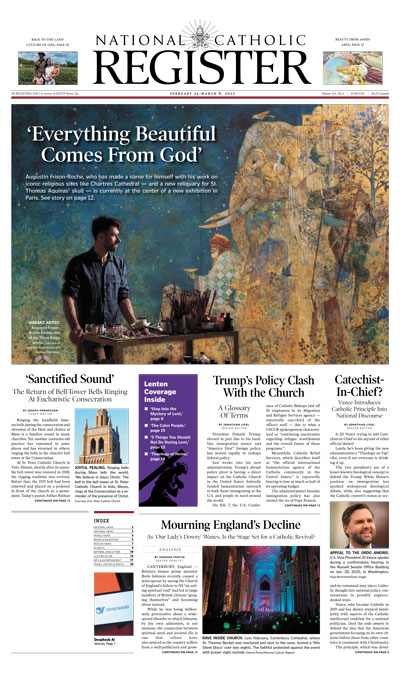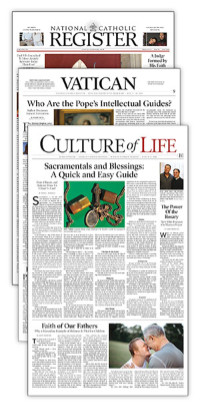Pope Francis’ Simple Tomb Marred by ‘Awful’ Letter Spacing, Designers Claim
Mistakes were made, apparently. ‘Woe be unto the person who decided to do it the way that they did it,’ one expert says.

Pope Francis’ simple, unadorned tomb had received almost universal praise until a torrent of criticism was unleashed by graphic designers out of alignment over how the Pope’s name was engraved on the white marble headstone.
The issue? The elegance of the austere tomb was, according to the designers, marred by the irregular spacing of the letters of the papal name.
As The New York Times reported, something was off with the “kerning” or spacing between the letters. Even to an unschooled eye, some of the letters appeared too close to one another and others too far apart.
Mark Wilson, writing at FastCompany.com, called it “objectively awful” in an essay compiling negative reactions to the tomb’s engraving. The “terrible spacing,” he said, made it look like “F R A NCIS VS.”
“Woe be unto the person who decided to do it the way that they did it, just because it’s a bad decision that will last for a long time, unless they change it,” the Times quoted Charles Nix, the senior executive creative director at Monotype, “one of the world’s largest typeface and technology companies.”
Rather than be buried at St. Peter’s Basilica, Pope Francis chose to be interred in the side nave of Basilica of Santa Maria Maggiore, tucked inside a niche near the icon of the Blessed Mother, Salus Populi Romani, which he visited before and after every international trip.
The simplicity of the Pope’s final resting place earned praise from a normally tough critic of the unbeautiful, art historian and author Elizabeth Lev.
She posted on X, “Went [to] Pope Francis’ tomb this morning — elegant, austere, a lovely addition to his beloved basilica.”
Lev was probably not focused on the engraving as much as how the tomb fit seamlessly into the 1,600-year-old church.
But people who make their living in typography? They noticed. And they’re an opinionated bunch — an internet search will result in dozens of articles with variations on the theme “My most hated fonts as a graphic designer.” So it’s hardly a surprise that graphic designers raised a stink about the way Pope Francis’ tombstone was engraved. The Vatican, for its part, has not commented.
Engraving is an artform, according to designer and calligrapher Paul Shaw, who wrote in an email to the Register that “the issue of letter spacing is a complicated one.”
“Today, experts in type, calligraphy and lettering believe that good letter spacing is optical. It is based on trying to optically equalize the space between letters,” Shaw said, explaining that this is difficult with Roman capital letters because of “their many odd shapes.”
The problem with Pope Francis’ tomb, he said, was that the engravers used something akin to Times New Roman font in its design.
“The Vatican should have followed Renaissance models for FRANCISCVS with classical capitals (closer to the Trajan typeface than Times Roman) openly spaced. Ideally, they should have been carved by hand and designed by the carver, not a copy of a typeface,” he said.
Michael Schmitt, a Catholic stonemason and artisan from Michigan who uses traditional methods to engrave cornerstones and memorials, agreed with the designers. He told the Register that the execution of the papal tombstone was regrettable.
“It just looks awful. It doesn’t look right. You don’t need a weatherman to know which way the wind blows. I mean anyone that looks at that inscription knows that it’s offensive to the eyes,” said Schmitt, whose company Schmitt and Sons specializes in hand-carved lettering and traditional stonemasonry.

Schmitt and his sons are currently building an Our Lady of Lourdes Shrine in Auburn Hills, Michigan. The shrine includes a large hand-carved inscription.
He doesn’t think the problem was with the font per se, but simply with the spacing.
Schmitt explained that for his carving work he uses Microsoft Publisher, which automatically spaces the letters properly. Proper lettering, he said, spaces out letters based on the center of each letter. Lettering is aesthetically pleasing, he explained, when the center of a letter is about the same distance to the center of the letters on either side of it.
So, what went wrong? Schmitt suspects it was too much attention to serifs, the small lines attached to the end of letters to make them look like pen strokes.
“It looks to me like they were trying to achieve an equal distance between the serifs,” he said, explaining that sometimes the serifs should almost touch each other to keep the centers properly spaced. Instead, on Pope Francis’ tomb, it appears that someone went out of their way to make sure that did not happen.
Nix, of the typeface company Monoface, however, told the Register that letter spacing ought not to be left to a computer program.
“Typography is, among other things, about rhythm and melody. The melody is inherent. It comes from the variety of letter shapes and the seemingly endless combinations in words. The rhythm is imparted by the typographer and/or designer’s skill in balancing form (the strokes of the letters) with the counter space (the area in and around the letters,” he wrote in an email.
In layman’s terms, he said, it’s about “eyeballing.” Nix likened the process to hanging a picture or decorating a room. “It has to feel right,” he said.
“When the job of spacing (or ‘fitting’) a font is more or less complete, we make extra adjustments to enhance the rhythm. Those adjustments, made between pairs of letters, are called kerning,” Nix said.
In failing to do this properly, it detracted from beauty of the tomb, in purely objective terms. But for Nix, it’s much more than that.
“Does it matter? Yes. It matters to typographers a great deal. For us, it’s the pursuit of an art. Does it matter to non-typographers? When it’s missing, it does — because it draws attention to itself. The form of language becomes a focal point — a disruption and a distraction.
“And it’s that that is most unfortunate in the inscriptional lettering on the Pope’s tomb,” Nix said. “We collectively long for a harmony in that most solemn moment. Instead, we find carelessness in the machine-like, perfunctory execution.”
Register staff reporter Matthew McDonald contributed to this story.
- Keywords:
- tombs
- graves
- praying for the dead

















